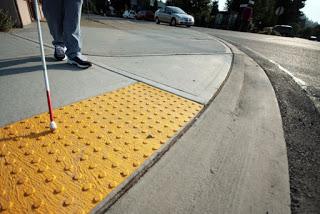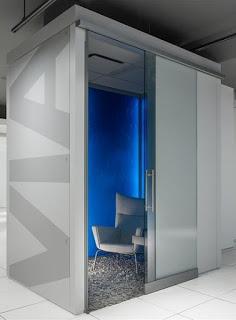As usual, the best way to answer that question is to pick a group which already has good accommodations and look at how this could apply to autism.
Beyond Acceptance, the example of the blind.
My comparison point this time is blind people. I'm not suggesting that nothing more can be done for them but rather that their needs are understood and catered for well beyond simple "acceptance". Our social care of visually impaired people is impressive and something that other groups should strive to match.So, how are the visually impaired being looked after by society?

- Braille: It's not just that braille exists, which is a great thing in itself, it's that people know what braille is and who it is for. That's a significant amount of awareness beyond simply "people are blind"
- Street crossings: In Australia, it's pretty much impossible to find a street crossing without the noises for blind people. It's been here for decades and it's very impressive.
- Bumps on the pavement: These started appearing decades ago and I thought they were just non-slip surfaces. It was only fairly recently that I understood what they were really for - and since then, I've seen many blind people taking advantage of them. I'm proud that the councils in our cities had the foresight to put these things in place.
- Canes and Dogs: I've found that people are generally quite aware of blind people and I've observed that they'll usually leave them alone if they have a dog or a cane but that if anyone sees a blind person having difficulty, they'll often rush in and help. I've also observed that most people are enlightened enough to know not to touch guide dogs.
The important things here are that people with visual impairments have progressed beyond simple concepts of awareness and acceptance and now have real-world adjustments for their difficulties integrated into our social and building codes. That's what we need to strive for in all forms of social difference.
Adjusting for Autism
How can we adjust our world to be easier for those with autism without necessarily making it difficult for those without? Here's a few examples which are admittedly mostly geared towards shopping malls but which could be tailored for other purposes too;Clothes without tags
 Tags are a constant source of irritation for a lot of kids with autism. They're scratchy against the skin and even when you cut them off, it's often hard to get the whole tag and you end up left with a scratchy burr.
Tags are a constant source of irritation for a lot of kids with autism. They're scratchy against the skin and even when you cut them off, it's often hard to get the whole tag and you end up left with a scratchy burr.I've noticed a trend on some T-Shirts recently where the tags are actually "printed" onto the shirt. Similarly, some shirts have the tags on the outside, on the cuffs or sleeves. This is something that Jeans have been doing for years with tags being on the belt or back pocket.
Clothing without tags is a trend that should be encouraged and recognised as autism-friendly / spd friendly.
Foods without mixtures
I have a seventeen year old at home whose only available McDonalds foods are fries and chicken nuggets without sauce. He won't eat burgers because the foods are all touching and because the sauces and mayonnaise affect the texture badly. You can imagine how difficult it is to find suitable foods when we visit a food court and more often than not, I cheat and get McDonalds because I know it's something that will work.It shouldn't be too difficult for food places to add one or two plain foods to their lineups, to sell foods with sauces separated or to provide plates in which foods don't touch.
Special Rooms

A Quiet Room
One of the biggest issues experienced by people with autism, particularly children and young adults is the lack of places to go when a meltdown is beginning. Meltdowns tend to come on suddenly but there are usually enough warning signs that some of the more aware people with autism (and/or their carers) can read them.If the signs of an impending meltdown are present, one of the most important things to do is to get the person disengaged from sensory overload. Having a quiet or private place to go is often the best option.
Unfortunately, in crowded shopping centres, the nearest equivalents of these quiet places are toilets and change rooms which are anything but quiet. Having a special area set aside for calming down could be something that a lot of people could benefit from. To make the room particularly special, care should be taken with the lighting to ensure that it doesn't flicker (no fluorescent bulbs) and smells (no perfumery etc).
Even just having a fenced-in outside balcony area with seats but not eating tables would be calming.
Lego areas
Similar to my comments on special rooms, most children's play areas are simply too noisy for many kids on the spectrum. One really good alternative would be to have play area at one end of a shopping center and a lego room at the opposite end. This would stop kids from taking the bricks out to the general play area and would keep the noise down.Many kids and young adults with autism would happily settle down and de-stress in lego rooms and these rooms would suit a lot of other types of people, particularly introverts.
Free Sessions on Autism for Parents and Teachers
Autism education is quite expensive and difficult to come by. The expense of the experts, venues and travel often puts it out of reach of the carers, parents, teachers and workers who need it the most. Having regular short local volunteer sessions covering specific aspects autism and other differences would increase the general levels of awareness and capability among these groups without breaking the time or financial budgets of those who need to attend.Many communities already have people on the spectrum who would be willing to give a little time to talk about their differences and of course, there must be local specialists around who would be willing to do a little pro-bono work to make positive changes in society.
Instead of inviting people from around the world and hosting in expensive facilities, communities need to look inwards at their local resources and cover costs with a little sponsorship in order to provide support to those who need it most.
Checkups, Advice and Talking Centres
I've noticed is that a lot of people with autism are lonely and need someone who understands them to talk to them without being judgemental. This is also true of people with advanced age, depression and other issues. If you're thinking of suicide, you can always call a lifeline service but unless it's life-threatening, people with general depression or conversational issues have nowhere to go.I'd like to see communities providing volunteers to visit people in their homes or in neutral places, check up on them and talk to them. I'm not referring to a full medical checkup, I'm talking about asking "how is your day going" or "do you have anything that you need help with".
This sort of thing would be good for people who have problems with paperwork or who need to call a professional, such as a plumber or handyman but don't know who to call.
There's a reason why couples tend to live longer than single people. It's because they have someone to listen to them, to offer advice and support.

Community Awareness campaigns
It feels strange to be writing "community awareness" here when I'm always complaining about the awareness campaigns, particularly "light it up blue".I'd like to see community awareness campaigns that don't ask for money but instead teach people how they can give help to those who need it.
Good examples, in slogan form, for this could be;
- "If it feels uncomfortable, you don't need to make eye contact" #autism
- "If a person with autism is having a meltdown, give them some space to calm down"
- "Your perfume smells nice, but it can cause sensory issues for kids with autism"
- "Not being understood? Try saying it a different way" #autism
- "fluorescent lights flicker -- and this can cause sensory issues for kids with autism"
- "Everyone with autism is different. The way you help needs to be different too"
There's a lot that we can do for people with autism but lets leave the whole acceptance thing behind us for now. Let's aim for the kind of changes that the blind community have seen. Positive and lasting changes that are fully integrated into society.

